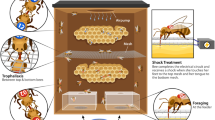Abstract
Food quality is a relevant characteristic to be transferred within eusocial insect colonies because its evaluation improves the collective foraging efficiency. In honeybees, colony mates could directly acquire this resource characteristic during trophallactic encounters with nectar foragers. In the present study, we focused on the gustatory responsiveness of bees that have unloaded food from incoming foragers. The sugar sensitivity of receiver bees was assessed in the laboratory by using the proboscis extension response paradigm. After unloading, hive bees were captured either from a colony that foraged freely in the environmental surroundings or from a colony that foraged at an artificial feeder with a known sucrose solution. In the first situation, the sugar sensitivity of the hive bees negatively correlated with the sugar concentration of the nectar crops brought back by forager mates. Similarly, in the controlled situation, the highest sucrose concentration the receivers accepted during trophallaxis corresponded to the highest thresholds to sucrose. The results indicate that first-order receivers modify their sugar sensitivity according to the quality of the food previously transferred through trophallaxis by the incoming foragers. In addition, trophallaxis is a mechanism capable of transferring gustatory information in honeybees. Its implications at a social scale might involve changes in the social information as well as in nectar distribution within the colony.




Similar content being viewed by others
References
Arenas A, Fernández VM, Farina WM (2007) Floral odor learning within the hive affects honeybees' foraging decisions. Naturwissenschaften 94:218–222
Bitterman ME, Menzel R, Fietz A, Schafer S (1983) Classical-conditioning of proboscis extension in honeybees (Apis mellifera). J Comp Psychol 97:107–119
Farina WM, Wainselboim A (2001) Thermographic recordings show that honeybees may receive nectar from foragers even during short trophallactic contacts. Ins Sociaux 48:360–362
Farina WM, Grüter C, Acosta LE, Mc Cabe S (2007) Honeybees learn floral odors while receiving nectar from foragers within the hive. Naturwissenschaften 94:55–60
Gil M, De Marco RJ (2005) Olfactory learning by means of trophallaxis in Apis mellifera. J Exp Biol 208:671–680
Goyret J, Farina WM (2005) Non-random nectar unloading interactions between foragers and their receivers in the honeybee hive. Naturwissenschaften 92:440–443
Grüter C, Acosta LE, Farina WM (2006) Propagation of olfactory information within the honeybee hive. Behav Ecol Sociobiol 60:707–715
Grüter C, Farina WM (2007) Nectar distribution and its relation to food quality in honeybee (Apis mellifera) colonies. Ins Sociaux 54:87–94
Jeanne RL (1991) Polyethism. In: Ross KG, Matthews RW (eds) The social biology of wasps. Cornell University Press, Ithaca, New York, pp 389–425
Kuwabara M (1957) Bildung des bedingten Reflexes von Pavlovs Typus bei der Honigbiene, Apis mellifica. J Fac Science, Hokkaido University. Zoology 13:458–464
Lindauer M (1948) Über die Einwirkung von Durf-und Geschmacksstoffen sowie anderer Faktoren auf die Tänze der Bienen. Z vergl Physiol 31:348–412
Lindauer M (1952) Ein Beitrag zur Frage der Arbeitsteinlung im Bienenstaat. Z vergl Physiol 34:299–345
Lindauer M (1954) Temperaturregulierung und Wasserhaushalt im Bienenstaat. Z vergl Physiol 36:391–432
Michener CD (1974) The social behavior of bees. Harvard University Press, Cambridge (404 pp)
Naug D, Smith B (2007) Experimentally induced change in infectious period affects transmission dynamics in a social group. Proc R Soc B 274:61–65
Oettingen-Spielberg T (1949) Über das Wesen der Suchbiene. Z vergl Physiol 31:454–489
Page RE, Erber J, Fondrk MK (1998) The effect of genotype on response thresholds to sucrose and foraging behavior of honey bees (Apis mellifera L.). J Comp Physiol A 182:489–500
Pankiw T, Page RE (1999) The effect of genotype, age, and caste on response thresholds to sucrose and foraging behavior of honey bees. J Comp Physiol A 185:207–213
Pankiw T, Page RE (2000) Response thresholds to sucrose predict foraging division of labor in honey bees. Behav Ecol Sociobiol 47:265–267
Pankiw T, Waddington KD, Page RE (2001) Modulation of sucrose response thresholds in honey bees (Apis mellifera): influence of genotype, feeding and foraging experience. J Comp Physiol A 187:293–301
Pankiw T, Nelson M, Page RE, Fondrk MK (2004) The communal crop: modulation of sucrose response thresholds of pre-foraging honey bees with incoming nectar quality. Behav Ecol Sociobiol 55:286–292
Park W (1925) The storing and ripening of honey by honeybees. J Econ Entomol 18:405–410
Pirez N, Farina WM (2004) Nectar-receiver behavior in relation to the reward rate experienced by foraging honeybees. Behav Ecol Sociobiol 55:574–582
Ratnieks WLF, Anderson C (1999) Task partitioning in insect societies. Ins Sociaux 46:95–108
Robinson G (1992) Regulation of division of labor in insect societies. Annu Rev Entomol 37:637–665
Rösch GA (1925) Untersuchungen über die Arbeitsteilung im Bienenstaat. Z vergl Physiol 2:571–631
Seeley TD (1982) Adaptive significance of the age polyethism schedule in honeybee colonies. Behav Ecol Sociobiol 11:287–293
Seeley TD (1989) Social foraging in honey bees: how nectar foragers assess their colony's nutritional status. Behav Ecol Sociobiol 24:181–199
Seeley TD (1995) The wisdom of the hive: The social physiology of honey bee colonies. Harvard University Press, Cambridge, Massachusetts
von Frisch K (1967) The dance language and orientation of bees. Harvard University Press, Cambridge, Massachusetts
Wilson EO (1971) The insect societies. Belknap Press of Harvard University Press, Cambridge, Massachusetts
Zar JH (1999) Biostatistical analysis, 4th edn. Prentice Hall, New Jersey
Acknowledgment
We are indebted to M. Spivak (University of Minnesota) for suggesting to us to combine trophallaxis and SRT experiments. We are also indebted to C. Grüter for his valuable comments and suggestions on an early version of this manuscript. This study was supported by funds from CONICET, ANPCYT (01-12319) and University of Buenos Aires (X 036) to WMF. The present study complies with the current laws of the state country in which experiments were performed.
Author information
Authors and Affiliations
Corresponding author
Additional information
Communicated by M. Giurfa
Rights and permissions
About this article
Cite this article
Martinez, A., Farina, W.M. Honeybees modify gustatory responsiveness after receiving nectar from foragers within the hive. Behav Ecol Sociobiol 62, 529–535 (2008). https://doi.org/10.1007/s00265-007-0477-0
Received:
Revised:
Accepted:
Published:
Issue Date:
DOI: https://doi.org/10.1007/s00265-007-0477-0




